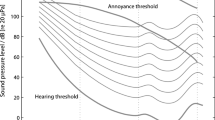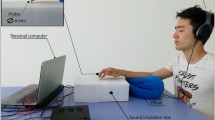Abstract
While the frequency response of the skin is described at macro level, there is a need to explore discrete areas of interest. The experiments described in this paper are part of a project that aims to build devices for cochlear implant (CI) users that meet music listening needs. The aim is to demonstrate that constant amplitude vibrotactile stimuli with distinct frequencies excite different areas of the hand with varying perceived intensity. 65 subjects took part in two within-subject experiments investigating the areas of the hand with most intense perceived sensation when exposed to various stimuli. Multinomial logistic regression was performed on the data and it was concluded that particular signals will elicit stronger sensations on some regions of the hand, and weaker on others. This indicates that there is a correlation between frequency of the stimuli and the area of the hand mostly stimulated.
Access this chapter
Tax calculation will be finalised at checkout
Purchases are for personal use only
Similar content being viewed by others
References
Birnbaum, D.M., Wanderley, M.M.: A systematic approach to musical vibrotactile feedback (2007)
Brisben, A.J., Hsiao, S.S., Johnson, K.O.: Detection of vibration transmitted through an object grasped in the hand. J. Neurophysiol. 81(4), 1548–1558 (1999). https://doi.org/10.1152/jn.1999.81.4.1548
Chafe, C.: Tactile audio feedback (1993)
Hopkins, C., Maté-Cid, S., Fulford, R., Seiffert, G., Ginsborg, J.: Vibrotactile presentation of musical notes to the glabrous skin for adults with normal hearing or a hearing impairment: thresholds, dynamic range and high-frequency perception. PLoS ONE 11(5), e0155807 (2016). https://doi.org/10.1371/journal.pone.0155807
Jones, L.A., Sarter, N.B.: Tactile displays: guidance for their design and application. Hum. Factors 50(1), 90–111 (2008). https://doi.org/10.1518/001872008X250638
Kyung, K.U., Ahn, M., Kwon, D.S., Srinivasan, M.A.: Perceptual and biomechanical frequency response of human skin: implication for design of tactile displays (2005). https://doi.org/10.1109/WHC.2005.105
Mahns, D.A., Perkins, N.M., Sahai, V., Robinson, L., Rowe, M.J.: Vibrotactile frequency discrimination in human hairy skin. J. Neurophysiol. 95(3), 1442–1450 (2006). https://doi.org/10.1152/jn.00483.2005
Mancini, F., et al.: Whole-body mapping of spatial acuity for pain and touch. Ann. Neurol. 75(6), 917–924 (2014). https://doi.org/10.1002/ana.24179
Merchel, S., Altinsoy, M.E.: Psychophysical comparison of the auditory and tactile perception: a survey. J. Multimodal User Interfaces 14(3), 271–283 (2020). https://doi.org/10.1007/s12193-020-00333-z
Morley, J.W., Rowe, M.J.: Perceived pitch of vibrotactile stimuli: effects of vibration amplitude, and implications for vibration frequency coding. J. Physiol. 431(1), 403–416 (1990). https://doi.org/10.1113/jphysiol.1990.sp018336
Mowbray, G.H., Gebhard, J.W.: Sensitivity of the skin to changes in rate of intermittent mechanical stimuli. Science 125(3261), 1297–1298 (1957). https://doi.org/10.1126/science.125.3261.1297
Rouger, J., Lagleyre, S., Fraysse, B., Deneve, S., Deguine, O., Barone, P.: Evidence that cochlear-implanted deaf patients are better multisensory integrators. Proc. Natl. Acad. Sci. U.S.A. 104(17), 7295–7300 (2007). https://doi.org/10.1073/pnas.0609419104
Stein, B., Stein, P., Meredith, M.: The Merging of the Senses. A Bradford Book, MIT Press (1993). https://books.google.se/books?id=uCV9QgAACAAJ
Verrillo, R.T.: Vibration sensation in humans. Music. Percept. 9(3), 281–302 (1992). https://doi.org/10.2307/40285553
Wilska, A.: On the vibrational sensitivity in different regions of the body surface. Acta Physiol. Scand. 31(2–3), 285–289 (1954). https://doi.org/10.1111/j.1748-1716.1954.tb01139.x
Acknowledgments
This work is supported by NordForsk’s Nordic University Hub and Nordic Sound and Music Computing Network (NordicSMC).
Author information
Authors and Affiliations
Corresponding author
Editor information
Editors and Affiliations
Rights and permissions
Copyright information
© 2022 The Author(s), under exclusive license to Springer Nature Switzerland AG
About this paper
Cite this paper
Paisa, R., Nilsson, N.C., Serafin, S. (2022). The Relationship Between Frequency and Hand Region Actuated. In: Saitis, C., Farkhatdinov, I., Papetti, S. (eds) Haptic and Audio Interaction Design. HAID 2022. Lecture Notes in Computer Science, vol 13417. Springer, Cham. https://doi.org/10.1007/978-3-031-15019-7_6
Download citation
DOI: https://doi.org/10.1007/978-3-031-15019-7_6
Published:
Publisher Name: Springer, Cham
Print ISBN: 978-3-031-15018-0
Online ISBN: 978-3-031-15019-7
eBook Packages: Computer ScienceComputer Science (R0)




